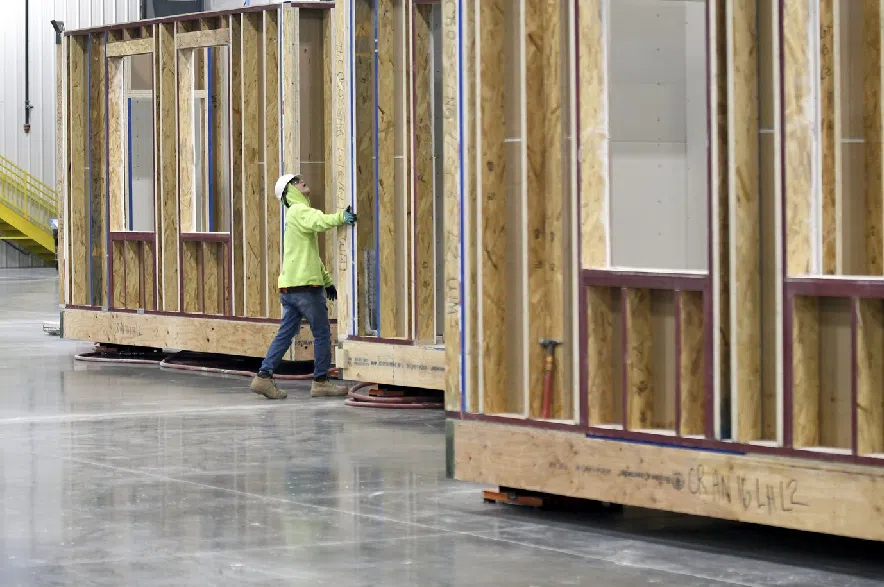TORONTO — When a church in Toronto’s west end was converted into affordable housing nearly 15 years ago, the group behind the project was already thinking ahead.
Andrea Adams, the executive director of the non-profit developer St. Clare’s, said she was “daydreaming” about what could be built on the yard next to the 20-unit building on Ossington Avenue.
Read More:
- Home sales down almost 10% annually last month: Canadian Real Estate Association
- Home prices in Saskatchewan hit record high in April, as inventory remains low
- New housing minister says he lacked tools to tackle homelessness as Vancouver mayor
She was eventually introduced to Assembly Corp., a company that builds mass timber modular housing, around the same time that the city was looking for proposals for “shovel ready” affordable housing projects.
St. Clare’s had the land, the contractor — and, more importantly, the will to get the project done.
The result is an eye-catching, three-storey building that’s now home to more than two dozen people who were experiencing homelessness.
“It’s a very assertive project,” Adams said in her office next to the L-shaped motel-style structure. Its residents, she said, “would have been people that were living in shelters or couch surfing or living in tents.”
The project is a small step toward addressing the cost-of-living problem in a province that saw 80,000 people experience homelessness in 2024, according to an Association of Municipalities of Ontario report.
Advocates and experts say while there is no single solution to the homelessness crisis that’s compounded by mental health and addictions issues, prefabricated homes could play a significant role in addressing the shortage of affordable and supportive housing.
“The modular definitely helps because the faster construction is, the least expensive it is,” Adams said.
The 25-unit complex on Ossington was erected in just 21 working days and overall construction took eight months.
The size of each small studio is around 220 square feet, with a bathroom, a kitchen and a living room. The modern, light brown exterior with large windows and shading fins draws the attention of passersby.
The structure “uses every square inch of property available to it and yet still looks beautiful,” Adams said.
Given the urgency of the homelessness problem, a lot more needs to be done, she said. “We need to do all the things and think of more things and then do those things.”
Lack of housing is a Canada-wide issue and by some estimates, the country needs millions of new homes for its growing population.
During the federal election campaign, Prime Minister Mark Carney promised a housing plan that would yield 500,000 new homes annually and provide $25 billion in loans for companies that make factory-built homes.
In his first news conference after the April 28 vote, Carney said he aims to create an “entirely new Canadian housing industry” around modular housing, using Canadian lumber, skilled workers and technology.
During the February provincial election, Ontario Premier Doug Ford also promised $50 million to support modular housing technology.
Experts say modular homes have several advantages that include a quicker construction timeline, cost effectiveness and an opportunity to build them in an environmentally friendly way.
The key to unlocking that potential is to create a stable demand for modular homes so factories can invest in them and hire workers with confidence, said Carolyn Whitzman, a professor and researcher at the University of Toronto’s School of Cities.
She said the new government’s investment in factory-built homes is a welcome move, but more needs to be done to make the plan a success.
“The trick is how can Canada get to the scale,” she said, noting modular construction isn’t as fast or cheap as it has the potential to be, and that could change if production ramps up.
“In order to build those factories and give people factory jobs, you need to have a certain level of demand. We simply don’t have that yet.”
She said the federal government could place an order for factories to build a specific number of modular homes for supportive, student or other types of social housing every year to help stimulate the market.
Though modular housing accounts for only four to six per cent of construction, it is becoming more popular in Canada, a report co-authored by Whitzman said.
Whitzman said Sweden is an example of a country that successfully turned to modular homes to address a housing crisis, with nearly 45 per cent of its homes built in factories.
In Canada, where industry labour shortages and long winters can delay construction timelines, prefabricated homes may alleviate some of those uncertainties, Whitzman said.
But despite its many advantages, modular housing isn’t a “magic bullet” for affordability. Significant government financial assistance and involvement is required, she said.
For the Ossington Avenue modular building, the federal government provided around $4.8 million in funding and the City of Toronto contributed approximately $1.7 million in the form of incentives, charge waivers and tax relief. St. Clare’s equity was estimated to be around $900,000.
Adams, the executive director of St. Clare’s, said the rent for each unit in the building is around $500 a month.
Modular units are an important part of Toronto’s affordable housing plan. Doug Rollins, the city’s director of housing stability services, said the goal is to build 18,000 supportive housing units by 2030, some of which will be prefabricated.
The city recently completed the construction of a five-storey, 64-unit prefabricated building on Kingston Road in the east end, with rent based on each tenant’s income, Rollins said.
“It will remain affordable and as their income changes, so will their rent,” he said.
Other modular housing projects are underway elsewhere in Toronto and builders say they’re seeing increased demand for prefabricated homes.
Luke Moir, who managed the Ossington Avenue project, said it is a “great example” of how unused land in urban centres could be transformed.
“It is a piece of the puzzle,” he said of prefabricated homes as a housing shortage solution.
Moir, who works as a project manager at Assembly Corp., the contractor that built the house for St. Clare’s, said such construction projects are also less disruptive because most components are made of wood and assembled off-site, meaning there is “a lot less nailing and banging, and then there’s no dust and grinding.”
In Ottawa, Theberge Group of Companies is working on its first factory-built home with eight apartments in the Westboro neighbourhood. Production began in early February. The modules were brought on site in mid-March and erected in just three days.
The project is set to be fully completed by the end of June, and the first tenant is expected to move in on July 1.
Jeremy Silburt, the company’s director of acquisitions, planning and development, said Theberge is expected to start working on a few more for-profit modular home projects in late summer.
Non-profit groups have reached out to the company about partnering to build affordable homes, he said, adding that modular homes cut the construction time by one-third.
“So it allows us to build a project a little bit cheaper, yes, but also very quickly and that saves us a bunch of money and time,” he said.
Smaller cities in Ontario have also adopted modular construction in an effort to build small homes fast.
Peterborough built a 50-unit complex in 2023, London constructed a 61-unit building in 2022 and Marathon, a town 300 kilometres east of Thunder Bay, has plans for a similar 20-unit project, according to the Ontario Real Estate Association.
This report by The Canadian Press was first published May 15, 2025.
Sharif Hassan, The Canadian Press











